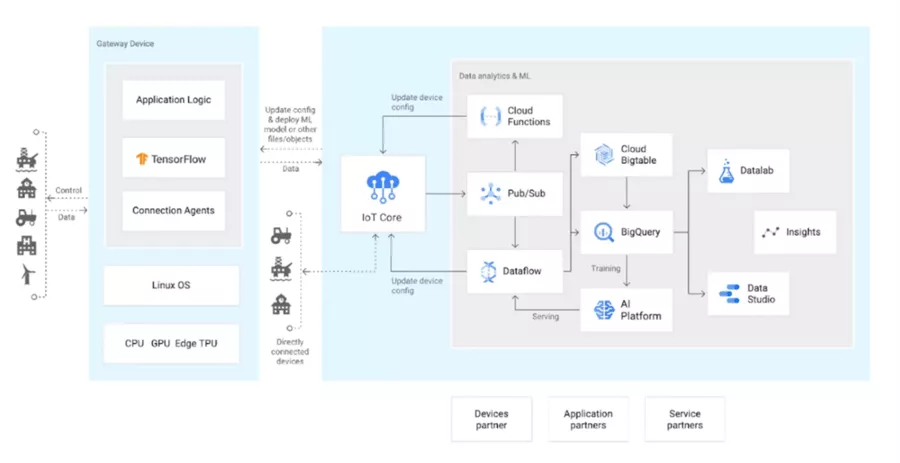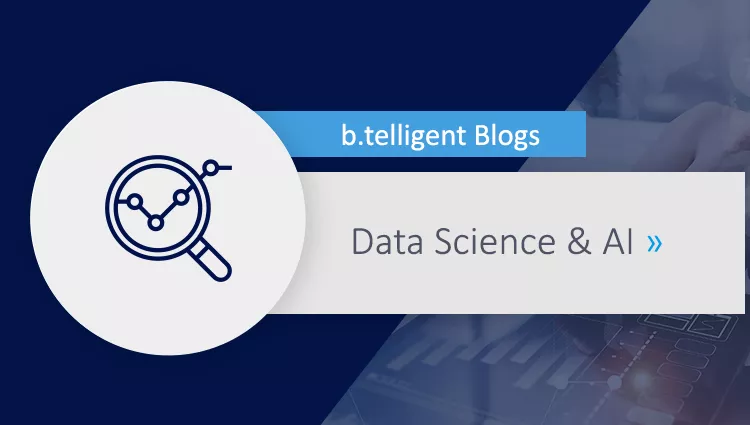Are you affected by Google's end-of-life announcement and need to replace the IoT core by August? Then this series of blog posts is the right place for you! The upcoming blog posts here reveal alternatives to the IoT core and show how you can integrate them into your existent GCP architecture.
Google und IoT – die verbotene Liebe?
In 2017, Google made the first official announcement that they wanted to get involved in the competitive market of the Internet of Things, and introduced a new IoT core service. It enables connection of devices via the MQTT protocol or HTTP to the Google cloud, and offers direct links to services such as Pub/Sub and Google cloud Dataflow. Shown below is an example of an architecture for data analytics with IoT data in GCP. 
After about five years, Google informed its customers in August last year that the offered IoT core service would be shut down and they would have to find an alternative by 16th August this year. A comparison of Google's IoT portfolio with that of its direct competitors such as Microsoft Azure or Amazon web services quickly reveals that the offer in Azure or AWS is much more extensive than Google's was. It therefore stands to reason that Google decided against making a larger investment in the IoT area, which would have been necessary to reduce the disparity with the competition. With its decision, Google is pursuing a different strategy than its two direct competitors, and relying on cooperation with partners as well as IoT platform providers. As a result, the enterprise reduces its risk and focuses more on its lucrative core business involving data platforms and analytics.
From Google's point of view, this step is understandable. However, customers who rely on Google's IoT core are faced with the question of how they can replace it with something equivalent.
What must a possible alternative be capable of?
To answer this question, we first need to take a look at the main functionalities of IoT core. In addition to direct links to Google's Pub/Sub and, thus, to further services in the field of data and analytics, the following functionalities are emphasized:
- Quick and easy setup: With IoT core, millions of devices can be integrated into a single system to ensure smooth and consistent data registration.
- Secure connections: Device authentication with public and private key pairs in conjunction with JSON web tokens (JWT).
- Device management: Once connected to the device manager, devices can be configured and managed right away.
- Integration with data & analytics services: Simple connection to analytics services offered by Google, such as Google cloud Dataflow, Google BigQuery, and Google cloud machine learning.
- Managed infrastructure: The overall solution comprises a highly scalable and fully managed infrastructure with pay-as-you-go GCP services.
Next we will use this range of functions as a basis for evaluating possible alternatives, and present you with a pre-selection from our portfolio.
Choose the right alternative for your needs!
BlogBlogThere are several alternatives to Google's IoT core. Some IoT platform solutions from technology partners are listed at the official site of Google. We will not examine any of these in this blog post or the subsequent ones. This blog-post series focuses on three very different variants of replacement:
- Multi-cloud solution: Integration of IoT services from Microsoft Azure or Amazon Web Services.
- Open source: Connect devices using an MQTT broker on the open-source data platform of Stackable.
- Platform solution: Device connection and management with the self-service IoT platform of Akenza.
The first solution continues to rely on fully managed and highly scalable cloud services. Google's existent IoT core can be replaced by comparable alternatives such as Azure IoT Hub or AWS IoT Core. In addition, this variant offers a possibility not only to replace Google's existent IoT core, but also use further services. We will discuss the offered services and their detailed integration into existent Google architecture in the next article of this series.
The second post of this blog-post series deals with an open-source alternative instead of multi-cloud solutions. This has the advantages of independence from manufacturers and higher transparency. We show how replacement of the IoT core offered by our partner Stackable can be integrated into your existent Google architecture, and describe the employed technologies as well as the advantages of open source in the IoT environment.
Finally, in our third blog, we and our partner Akenza will jointly present their IoT platform. The focus here is on the IoT platform's architecture, as well as possibilities of connecting and managing devices and deploying them in existent Google architecture.
The countdown is on - we show you the alternatives!
You already know how you want to replace the Google IoT core? Or would you like to start already before the end of this series? Contact us and we will support you in implementation with our expertise and b.telligent's partner network!









